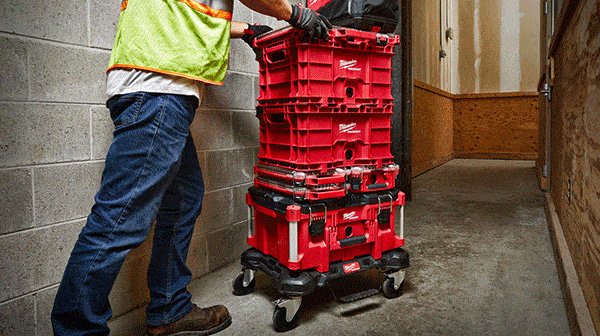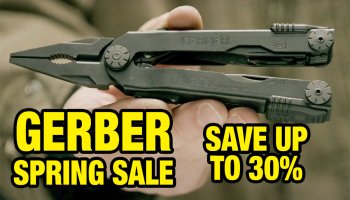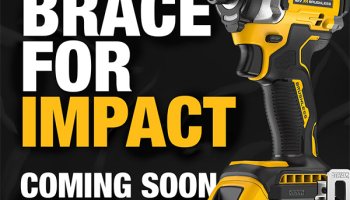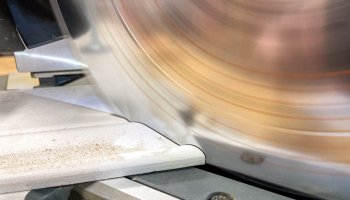
If you buy something through our links, ToolGuyd might earn an affiliate commission.
I wrote about a new line of Tekton customizable tool carts the other day, and a couple of readers made comparisons to Milwaukee’s Packout system.
So, let’s compare the two storage options and how they differ from each other.
Tekton Tool Carts
To start off, the Tekton tool carts have a 31″ wide x 21″ deep foot print, and with 33″ or 37″ height.
You get 2 shelves at the least – top and bottom compartments – and can add up to 3 full-extension drawers.
The casters are on the small side, and if they’re anything like other tool cart casters, they’re designed for rolling around an indoors workshop.
Tool carts are generally designed for automotive maintenance garages, and are used in a similar manner by other types of users. You might see them in all kinds of indoors workshops – machine shops, hobbyists spaces, commercial sites, and so forth.
You can place larger tools or bulk supplies on the bottom shelf, and the drawers and top compartment are sized for hand tools. Smaller power tools can fit in many tool cart drawers, but it depends on the size and type of tool.
Milwaukee Packout Tool Boxes

Milwaukee Packout is a system of modular tool boxes.
There are drawer units, a rolling dolly, different sizes of tool boxes, organizers, crates, a rolling tool box, tool bags, and more.
Focusing on their large tool box, its exterior dimensions are 22.1″ wide x 16.2″ deep x 11.1″ tall. This means that a Milwaukee Packout tool box tower has about half the footprint of Tekton’s tool cart.

You can buy Packout-equipped tool carts from some industrial suppliers, but you’ll get better pricing if you everything individually.
Still, the storage structure is very different.
The Milwaukee Packout system expands regularly with new tool box, organizer, and accessory options, and now there are also powered accessory integrations such as a vacuum and LED lighting product.
All Packout mobility configurations – the customizable cart is not an official Milwaukee product – are designed with versatility and portability in mind.
A fully-loaded Packout tower doesn’t move very easily on its 4-wheel dolly, but that dolly can go across varied flat terrain with greater ease than a tool cart would. If you need to transverse rocky or uneven ground, the rolling cart or 2-wheel hand cart are better options.
Neither are “Better”
Honestly, it’s not a competition, and not because one is clearly better than the other.
Tekton’s tool cart and Milwaukee’s Packout system are two completely different solutions aimed at very different user needs.
While the argument that Milwaukee Packout is less expensive than Tekton’s new tool carts is accurate, it’s more of a subjective take on things. To hold the same amount of tools, how would you configure a Milwaukee Packout configuration. You might need a pair of of 4-wheel dollies, each stacked with a crate on the bottom, a 3-drawer tool box, a crate on top, and a flat work surface to top it all off. All that would be a chore to work out of compared to a traditionally configured tool cart.
Milwaukee Packout can be mounted in a work van. The Tekton tool cart can hold 100 lbs per drawer. Milwaukee’s Packout 3-drawer tool box has a total weight capacity of 50 pounds, but you can pick up and move the Packout 3-drawer tool box and place it on a (properly rated) shelf.
Tekton’s tool cart will be more convenient to work out of. Milwaukee’s Packout has better options for storing a circular saw.
Tekton’s tool cart is largely made from metal. Packout tool boxes are made from impact-resistant plastic with metal reinforcement and components where needed.
For most users, the tool cart will be more useful if they’re working in an established space, and the Packout modular tool box system if they’re taking their tools and supplies into the field. A tool cart can be wheeled down a hallway, but you’re not going to load it into a work van to be taken to a jobsite.
Some users, such as MRO (maintenance, repair, operations) professionals, might be able to go either way. But generally, tool carts are for indoors use and Packout tool boxes for field use.
I use a lot of Milwaukee Packout products in a workshop setting, and I also have a tool cart and other forms of stationary storage. Sometimes they can be interchangeable, but usually only in small ways.
It might seem silly to compare the two very different product systems against each other, but while distinctly different there are some areas of overlapping function and convenience.

It’s also worth pointing out that Festool has different drawer and docking accessories for their Systainer modular tool boxes.

Milwaukee does too – they have shelves, individual shelves, and a wall mount that can be attached to vertical or horizontal surfaces.

And, I recently showed readers a brief example of Facom’s mobile tool box and ToughSystem tool box integration. Here, there’s a typical automotive or aviation industry rolling tool box with portable modular tool box storage bolted to its side.
The line between workshop and mobile storage has been blurred, and deeper expansion into modular tool storage products by Milwaukee Tool and others are erasing the traditional boundary even further.
A portable tool box used to be a singular plastic or metal hand box that fit a jumble of different hand tools, power tools, and supplies. Tool carts are essentially smaller mobile tool cabinets with a mix of bulk and shallow storage compartments.
Modular tool box systems, especially Milwaukee Packout, have introduced new workshop and field use storage options, but they’re still fundamentally different from mobile tool carts.
What remains clear is that both types of products definitely serve very different types of users.
Unless Milwaukee introduces some very big Packout surprises, at this time any comparison between modular tool boxes and tool carts are going to be matters of opinion. There’s no even ground for objective comparison, at least not yet.
Summary
I figure that even if an objective comparison isn’t possible, it might still be helpful to look at each system’s general pros and cons.
Tekton Tool Cart Pros
- Larger footprint – holds more
- Greater focus on hand tool storage
- Primarily constructed from metal
- Higher weight capacity
- Open bottom shelf for bulk storage
Tekton Tool Cart Cons
- Not designed for use outdoors
- Small wheels
Milwaukee Packout Tool Box System Pros
- Different tool and parts storage options- tool bags, organizers, boxes, crates
- Tool boxes can be reconfigured
- Can be separated for carrying
- Impact-resistant
- Weather-resistant (most products)
- Different mobility options for varied terrain
- Wall and vehicle mounting options
Milwaukee Packout Tool Box System Cons
- Limited storage volume
- Slower access in a workshop setting
- Tool boxes in a stack are inaccessible (except for top box or drawer units)
- Lower drawer weight capacity (50 lbs per drawer box)







